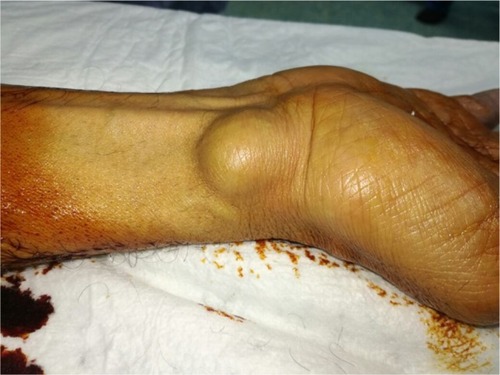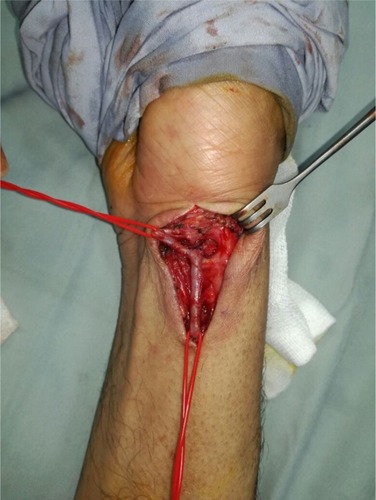Abstract
Introduction
The incidence rate of true non-traumatic radial artery aneurysms (RAAs) is low, and very few cases have been described. The majority are traumatic in origin and are iatrogenic pseudo-aneurysms following arterial cannulation. However, other rare causes such as vascular tumors, connective tissue diseases, and occupational injury have also been reported. Only eight cases were reported as idiopathic true RAA. Herein, I describe a case of true idiopathic distal RAA, which was managed by surgical repair.
Case presentation
A 61-year-old-man with no significant medical history presented to vascular clinic with complaint of a nontraumatic mass on the volar aspect and radial side of his right wrist for 6 years. Duplex ultrasound and computed tomography angiogram revealed distal RAA. It was managed by open surgical resection with primary end-to-end anastomosis. Histopathological studies revealed true aneurysm of the distal radial artery.
Conclusion
True distal RAAs are an extremely rare entity. Unawareness of this condition might lead to inappropriate management with significant morbidity. Surgical management is generally indicated, but the best treatment remains controversial.
Introduction
The upper limbs are considered less vulnerable to arterial diseases, especially those of aneurysmal nature, and radial artery is the least artery affected by aneurysmal disease after subclavian, brachial, and ulnar arteries.Citation1 Radial artery aneurysms (RAAs) are rare entities comprising only 2.9% of all upper extremity aneurysms.Citation2 They are mostly pseudoaneurysms and associated with trauma, usually penetrating or iatrogenic.Citation1,Citation3 However, true aneurysms of the radial artery are extremely rare. Only eight cases were reported as idiopathic true RAA. Herein, I report a case of an idiopathic isolated aneurysm in the distal radial artery with the clinical presentation, diagnostic modalities, and surgical management.
Case presentation
A 61-year-old male patient with insignificant medical history presented to vascular clinic from orthopedic clinic with complaint of a mass on the volar aspect and radial side of his right wrist (). He started to notice this mass since 6 years. It was small and had gradually increased in size. He denied any history of trauma or previous cannulation at the same site. He is a barber and a nonsmoker. On physical examination, the mass was 3×3 cm, there were no skin changes, and it was pulsating. Allen’s test was positive. There was no evidence of other aneurysms in both upper and lower limbs by physical examination. A trial of needle puncture of the mass was performed at orthopedic clinic before referral and revealed arterial blood flow, and so he was referred to our vascular clinic.
Doppler ultrasound and computed tomography (CT) angiogram (CTA) showed a 3×3 cm isolated distal RAA with normal ulnar artery and intact both deep and superficial palmar arches ().
On patient request and taking into account the potential risks such as thromboembolic complications or even rupture, a surgical repair was decided and performed. Under local anesthesia, a 4 cm longitudinal incision above the aneurysm was done. A saccular aneurysm was identified at the distal part of the radial artery after the takeoff of the superficial palmar arch branch (). Then, the proximal, the distal radial artery, and the origin of the superficial palmar arch were controlled. Excision of the aneurysm was done, and the excised specimen was sent for histopathology. Arterial continuity was restored by primary end-to-end anastomosis between proximal and distal radial artery (). The postoperative course was uneventful, and patient was discharged on the same day on simple analgesia. The histopathology report showed a dilated arterial sac with intraluminal mural thrombus.
Discussion
Shaabi et al reported that in 1966, RAA was first recognized by Thorrens, and since then some reports have been published.Citation4 The majority of studies reported traumatic pseudoaneurysms, and only few authors reported cases of “true idiopathic” aneurysms.Citation4
The initial diagnosis can be made clinically.Citation5 Most cases present as an asymptomatic pulsatile swelling.Citation6 It can be presented with complications such as distal thromboembolism, digital ischemia, rupture, hemarthrosis, adjacent nerve irritation, paresthesia, limited wrist mobility, skin ulceration, and secondary infection.Citation2 Misdiagnosis of a ganglion remains the pitfall.Citation3 Other differential diagnosis includes synovial cyst, lipomas, and neuromas.Citation1
Preoperative imaging will help in the diagnosis and to determine the most appropriate surgical management, including the need for vascular reconstruction.Citation4,Citation7 Duplex ultrasonography can play an important role in distinguishing true arterial aneurysms from pseudoaneurysms and the quality of in-line flow proximal and distal to the lesion in question.Citation2 Preoperative angiography can also be a valuable tool to help identify associated vascular pathologies such as arteritides, arteriovenous fistulas and malformations, fibromuscular dysplasia, and venous anomalies.Citation2
RAA should be treated rapidly because of the local and systemic risks of complications.Citation2,Citation8 The method of treatment remains controversial.Citation1,Citation3 It can include simple ligation, excision with primary anastomosis, or an interposition graft.Citation6 Previous reports had concluded that the treatment of choice is resection of the aneurysm and arterial reconstruction with primary end-to-end anastomosis or proximal and distal ligature of the vessel.Citation8 Others had reported that the most common approach for RAAs is ligation and excision, which appears to be the preferred in cases where the ulnar artery is the dominant arterial supply for the hand.Citation6 Transcatheter therapeutic options such as covered stent exclusion, coil, and polymerizing agent embolization are extremely limited and ill advised given the local anatomical restrictions.Citation2 In the case described here, although there was adequate reflux from the distal radial artery, the decision to restore arterial blood supply by end-to-end anastomosis of the radial artery was done because there was no segmental defect and healthy appearing arterial stumps.
Conclusion
Distal radial artery true aneurysms are extremely rare entity. Unawareness of this condition might lead to inappropriate management with significant morbidity. Surgical management is generally indicated, but treatment of choice remains controversial.
Informed consent
The patient gave a written informed consent for the case report and included images to be published.
Disclosure
The author reports no conflicts of interest in this work.
References
- MeiraLEGouvêaTMMacedoTjdeIdiopathic radial artery aneurysm: case reportJ Vasc Bras2011104315318
- NassiriNKoganSTruongHNagarshethKJShafritzRRahimiSSurgical Repair of a Snuffbox Radial Artery PseudoaneurysmClin Surg201611154
- WaltonNPChoudharyFIdiopathic radial artery aneurysm in the anatomical snuff boxActa Orthop Belg200268329229412152378
- ShaabiHITrue idiopathic saccular aneurysm of the radial arteryJ Surg Case Rep201420146rju05824898410
- DeşerSBDemirağMKTrue Radial Artery Aneurysm Presenting With Behçet’s DiseaseArch Rheumatol2017322177178
- ThaiHVasylukARitsYBilateral Radial Artery Aneurysm: Case Report and Review of LiteratureVasc Med Surg20164247
- JedynakJFrydmanGIdiopathic True Aneurysm of the Radial Artery: A Rare EntityEur J Vasc Endovasc Surg2012445527
- GabrielSADe AbreuMFDe AbreuGCTrue posttraumatic radial artery aneurysmJ Vasc Bras2013124320323




